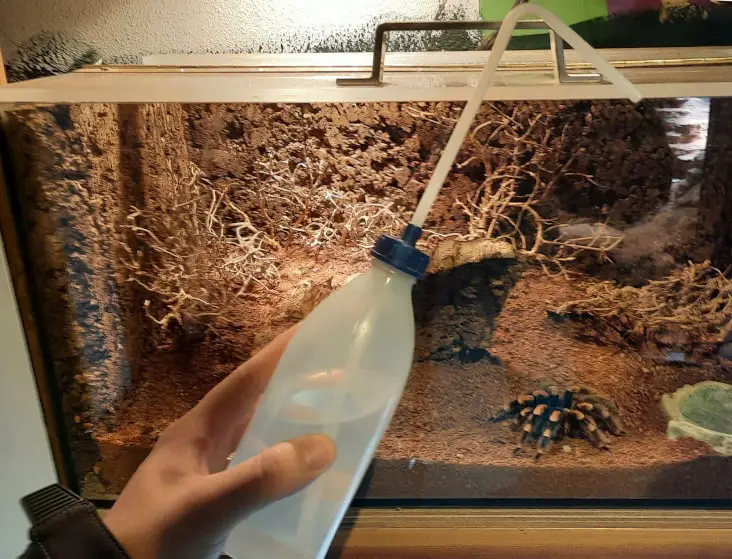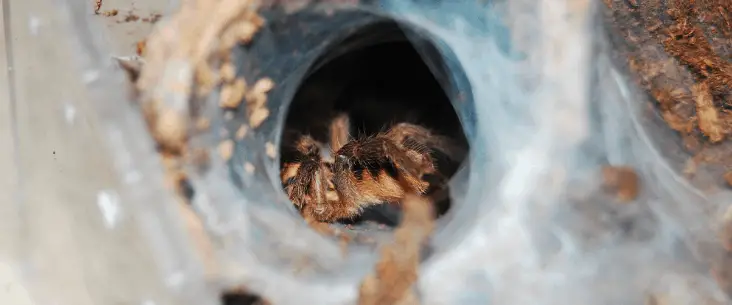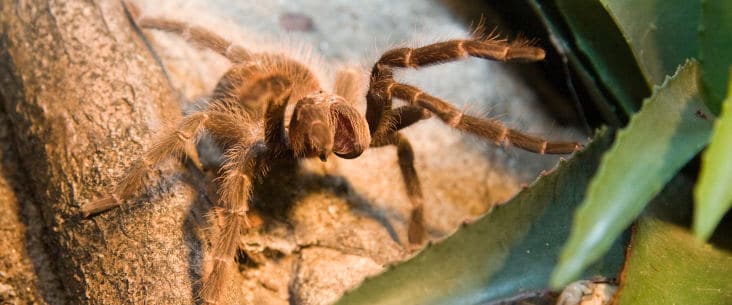Do tarantulas drink water? There are many viewpoints on the subject of providing water for tarantulas. This can lead to confusion, and with some misinformation and myths out there, it can be difficult for new tarantula keepers to know how to hydrate your tarantula. To help new tarantula keepers better understand all about this topic, we developed this comprehensive guide. If you have a question about hydrating a tarantula, you’ll probably find the answer in this guide.
All tarantula species of all ages will drink water, and therefore, they all need a water dish. A water dish is safe for them and they will not drown in it. Whatever type of water dish you have, and wherever you place it in the enclosure, a tarantula will find it when it is thirsty.
Although it might sound straightforward, there is much to learn about hydrating tarantulas. After reading this practical guide, you know everything there is about this important topic. So, are you ready to dive in?
Do tarantulas really need water?
A question that is often asked on many forums is if tarantulas really need water. And it isn’t even that strange that (new) keepers ask this question. Mostly because you rarely see a tarantula drink. However, now in the day of the internet and Youtube, we know better. There are many videos of tarantulas drinking from a water dish.
Besides that, there is practically no organism on this planet that can do without water. Water makes it possible that life exists in the first place. So it is a clear YES — tarantula really need water as well! Without water, a tarantula can’t survive.
How much water do tarantulas drink
It is difficult to pinpoint exactly how much water a tarantula ‘drink’. It also depends on the species and individual needs. And it is not that straightforward like with many other animals. Tarantulas are very efficient with their liquid household in their body. Tarantulas relatively do not need much drinking water.
But there is more to it. They not only acquire water from, for example, a water dish. Humidity provides water as well, and even when it is not visible to the eye, it provides hydration for your tarantula. Humid air keeps your tarantula hydrated as well. That doesn’t mean you need to mist spray the enclosure every hour. It doesn’t work that way. Not all tarantulas like a humid environment and some are best to keep relatively dry.
Another way they acquire water is from their food. Insects provide a juicy snack and, at the same time, keeps your tarantula hydrated as well. It is the same for us humans. We can stay hydrated for a long time with juicy fruits and vegetables. Endive or cucumber, for example, contains more than 80% water.
Tip: If you like to see a tarantula drink, you have a higher chance to observe this behaviour after your tarantula has moulted. They are often thirsty after the intense process of a moult.
How long can a tarantula without water?
Actually, tarantulas can’t go long without water. It is often thought so because you rarely see them drink. But that is because they find water in other ways, like within their food and from the humid air or substrate.
Tarantulas can regulate their metabolism in unbelievable ways but still need water to survive. They can go much longer without food (some records say that a tarantula can live without food for two years) but will much quicker dehydrate when they don’t have access to water. So, it should never be a question: They should have water available at all times.
However, it is not that strict — a tarantula can easily go without a filled water dish for several days without having problems that your tarantula will dehydrate, but that is — again — because they can attain water from the humid environment and their food.

How to provide water for your tarantula: The water dish
To they really need a water dish?
Like with every pet, some topics are more debated on than others. And so is this part a hot topic in the tarantula-keeping world. It is often debated how to provide water to your tarantula and if tarantulas need water in their enclosure or that they get enough from their food. This article has an excellent discussion about the usefulness and need for water dishes in a tarantula enclosure.
But tarantula’s don’t have water dishes in the wild, so why should they need one in captivity? This argument is one often used to argue the need for water dishes. Of course, indeed, tarantulas don’t have plastic or ceramic dishes in their wild habitat.
However, it is difficult to exactly mimic their natural condition in a captive setting. In nature, they have rain, puddles, little water streams to drink from. This is rather difficult to mimic the right conditions in your enclosure because the enclosure has such a small surface. You could make some sort of little water stream in the enclosure if it is big enough (which means a much bigger enclosure is needed than that tarantula keepers normally use).
In my experience, a water dish is always highly appreciated by tarantulas. Besides that they sometimes really drink from it, they also like to stand in it with one or two legs. And a dish also increases the humidity of the enclosure, which is preferred by most species. So, from my point of view, a water dish is indispensable for the tarantula.
What size and type of water dish
You can use a lot of objects as a water dish. For the tarantula, it does not matter that much. If you care about the aesthetics of the enclosure, you could choose from a wide range of plastic or ceramic water dishes shaped in the form of a rock or piece of wood. These water dishes look nice in the tarantula enclosure, are easy to clean, will last for a long time (as long as you don’t let them fall) and are not that expensive. Between $5 and $10, you have already a good looking water dish.
However, If aesthetics don’t mind and cost do, you can use many other objects as a water dish. Any glass, ceramic or plastic dish will as long as it is not too small (or too large), and it would be best if they are not that high (¾” / 2cm is more than enough).
Other products that are often used as water dish are bottle caps. They work really well, are cheap (or free) to collect from larger bottles. Make sure to clean them thoroughly before using them tough. Smaller bottle caps are ideal for slings (baby tarantulas). Don’t worry; they will not drown in it. Actually, they can float on the surface of the water.
Do I need to put a sponge in the water dish?
Many people worry about the possibility that their spider drowns in the water dish. Therefore, oftentimes and common advice from pet stores is to place a sponge in the water dish to prevent drownings. But it is completely unnecessary to put a sponge in the water dish. Let me explain why.
First, tarantulas won’t drown in their water dish unless your tarantula is very ill (but even then, it is almost implausible). Even when they place their mouthparts completely underwater for a long time, they will never drown simply because they breathe from tiny holes in their abdomen (where the book lungs are located). As long as their book lungs are not submerged in water, a tarantula won’t drown. A water dish is just too small for them to completely be submerged.
Next to that, the cuticular hydrophobicity functions to keep tarantulas dry and they are well supported by the water’s surface tension. Or in simpler words, water will slide right of their body, and they will float on water surfaces, so they will not be submerged in water easily. And at least not with a simple shallow water dish. This also applies to slings, so they can get a (smaller) water dish too without using a sponge.
Adding a sponge to the water dish does not have any perks for the tarantula. It only creates additional cleaning and a potential breeding ground for bacteria.
Where to place the water dish
I like to place the water dish on the other side of where the tarantula made its burrow or webs the most. It is less likely that it will poop or throw dirt in the water dish. But don’t be surprised it still will. They just like to throw stuff in their water dish (that keeps us busy).
Place the water dish stable on the substrate ground, maybe dig or push it in the substrate a little. Even for arboreal tarantulas, a water dish is appreciated and can be placed on the substrate floor like with other spiders.
How often change the water
Well, the answer to this question is a large ‘it depends’. It depends on the evaporation of the water, the mess they make from their water dish, the amount they really drink, the size of the water dish. A normally change the water every other day and with some individuals even every day. Then I’m sure that they always have fresh, clean water available, although some make a game out of it to throw all kind of stuff in their water dish as soon as I refresh them.
Actually, for every pet animal, I maintain the rule that they need clean water every day. And although a tarantula will drink much less than cats, dogs and other mammals, I want to be sure they have it available almost all the time.
Refilling the water dish is easy. I use a plastic squeeze bottle with a curved spray nozzle. This way, I can refill the water dish without disturbing the animal. This bottle makes it easy to dose the water and precisely fill the water dish; however, a squeeze bottle is also easy to moisten the substrate, so now and then.
Other ways to refill the water dish can be done using a syringe, pipette or carefully with a water bottle. However, I’m not particularly eager to pour water from a water bottle because it tends to spook my tarantulas even if I’m cautious with it. It also splashes more. When the spider is sitting close to the water dish, water ends up on the spider, which it really doesn’t like.
When I refill the water dish, I let it flow over a little to make the substrate moist around it to keep the humidity up. A syringe with a metal tip is an easy way to moisten the lower layers of the substrate. Slowly squeeze it, allowing the substrate to soak up the water. Please don’t overdo it and let the substrate get soaking wet.

Can tarantulas drink normal tap water?
In many countries, normal tap water is perfectly fine to use as drinking water for your tarantula. If they do not add any additives in your country or state, and water is of good quality, then I see no problem giving it to your spider.
If you have doubts or if you know that they add certain chemicals to it, it would be better to give water from a bottle or that is cleaned with a reversed osmosis. Some trace amounts of certain minerals can be unhealthy or even lethal to your tarantula.
In some countries, you can get osmosis water rather easily from pet or aquarium shops. They may charge a small fee, but many times it is free, and you can fill up a jerry can to provide clean water to your tarantula for several weeks.
Can tarantulas dehydrate?
Yes, when kept under the wrong circumstances, tarantulas can be dehydrated. Actually, it is one of the most common problems with tarantulas kept in captive conditions (unfortunately). Besides health issues, it also increases the probability of problems during moulting. More on that in the article: Can tarantulas die while moulting?
When humidity is kept around 60%, and you have provided a water dish 24/7 to your tarantula, it will be doubtful for your tarantula to dehydrate. However, if you live in an arid climate and/or have low humidity in the enclosure due to too much ventilation, your tarantula can become dehydrated.
Although tarantulas can go surprisingly long without food, they can’t go long without water. So providing water regularly is essential for them to be kept hydrated.
GOOD PRACTICE TIP: When filling the water dish, let it overflow a little to moisten the surrounding substrate. This will increase the humidity of the enclosure.
What are the signs of dehydration?
How do you recognize a tarantula that is hydrated? The most obvious sign of a dehydrated tarantula is that it has a smaller than normal and shrivelled abdomen. It looks like the abdomen is sunken. When you see these signs, it is a red alert because then the spider is already quite far dehydrated. You should take action fast. Sometimes it is also sitting in a semi-death curl position.
However, before this stage of dehydration, your spider becomes slow-moving and lethargic first. This more subtle sign should already flag your attention to provide water and increase the humidity.
But your tarantula may tell you already earlier that it prefers more moisture in its environment. When you see your tarantula sitting in its water dish for long times (like days), it may suggest that the humidity is too low for him or her. Although a tarantula likes to place one foot in its water dish, it should move throughout its enclosure. When arboreal species are on the ground next to the water dish can also a clear sign that humidity is too low.
What to do when a tarantula is dehydrated?
If you see the first signs that your spider wants more moisture, just provide a full water dish and spray/moisten the substrate to increase the humidity. That is often more than enough, and your spider will soon be its normal self.
When your spider is more severe dehydrated, more intense action is required. Start with providing a large, shallow open dish immediately close to your tarantula. It should climb into the water dish and start drinking. Within hours you see the abdomen increase to normal size, replace the lost moisture in its body.
If it does not start to drink or move into the water dish to dip its chest in it, start carefully to moisten the substrate directly around the tarantula. You could also decrease ventilation by taping the ventilation holes, but keep some ventilation open. You could carefully place the spider with its mouth into a shallow filled water dish to make it easy for them to drink. Never place a weakened tarantula with its abdomen in the water dish because this is a situation that a tarantula can drown.
When you take these steps, and with some luck, your tarantula will recover quite quickly (hours to one night) from dehydration and will be completely its normal self within days. After the intervention, it is important to analyse what the problem was, how it could happen and make adjustments it will not happen again.
Much more to learn!
There is much more to learn about keeping tarantulas. For example, how to clean a tarantula enclosure? You can find more articles about tarantulas with plenty of practical tips to better understand and enjoy keeping tarantula spider as a pet.
Share this page!



